The Lilly Pilly plant is a fantastic tropical, ornamental native, with some varieties growing delicious little fruits. This fantastic plant can grow quite large in the wild, but there are also many dwarf varieties you can grow at home.
With wonderfully dense foliage, many varieties also make for a perfect lilly pilly hedge. Here’s our guide to help you propagate, grow and care for lovely lilly pilly plants.
More...
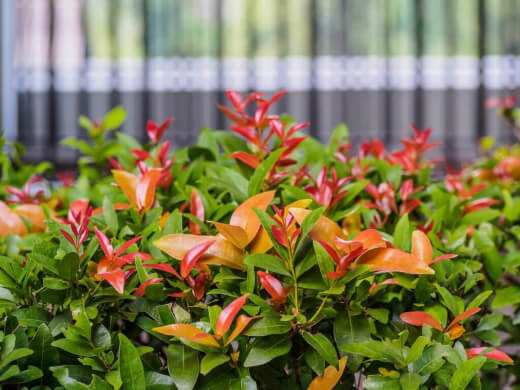
Family: | Myrtaceae |
|---|---|
Genus: | Acmena, Syzygium |
Common Names: | Lilly Pilly |
Location: | Outdoor |
Type: | Tree, plant |
Growth: | 5 to 30 metres tall (depending on variety) |
Sun requirements: | Full sun to partial shade |
Foliage Colour: | Green |
Flower Colour: | White, pink, green |
Flowering: | Spring |
Fruit: | Pink, reddish-purple fruits mature in summer |
Maintenance level: | Low |
Poisonous for pets: | Non-toxic to cats and dogs |
Getting to Know the Lilly Pilly Plant
Lilly pilly is native to Australia and some parts of SouthEast Asia. Formerly known as Eugenia, Lilly Pillies now form part of the Syzygium or Acmena genus.
They are technically part of the Myrtaceae family.
Other common names you may find this plant under include:
- Monkey Apples
- Cherry Satinash
- Australian Cherries
More so, aboriginal Australians refer to this plant as “medicine berries’ as the fruits of the lilly pilly have quite a few health benefits. Due to its fast-growing, dense and glossy foliage Lilly Pillies are great as a natural fence, protective screen or private lilly pilly hedge.
Plus, they are likely to attract lots of birdlife to your garden.Widely cultivated varieties of Lilly Pilly include the Sublime, Red-Head, Straight & Narrow and Pinnacle varieties. All these varieties can make for excellent garden ornamentals or hedges.
The sublime and straight and narrow varieties are ideally used for hedging. Whereas the Red-Head cultivar is commonly grown for its fruit and fire-retardant capabilities.
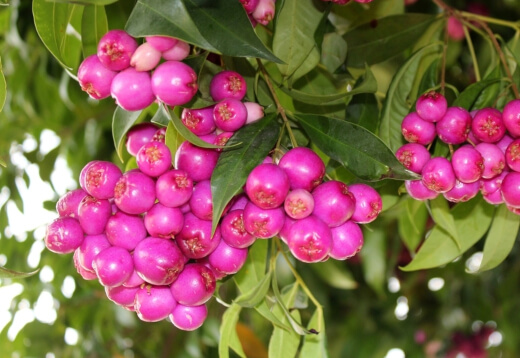
Source: Yates.com.au
The fruits of the red-head are oval-shaped berries that range in colour from a pink-red to a violet or magenta colouring. These fruits are usually quite tart when freshly picked but also have a fruity, spice-filled flavour said to be close to that of cinnamon.
Common Lilly Pilly Varieties
It is important to note that the Acmena genus, commonly referred to as Lilly Pilly, has many different botanical names including Eugenia, Acmena and Syzygium. The Acmena varieties tend to have more upright foliage and smaller leaves whereas the Syzygium varieties tend to be larger growing trees.
Australia boasts over 60 different varieties of Lilly Pilly where most fruits are edible, making Lilly Pillies excellent bush tucker plants. Growth habits range from small bushes to big trees.
These are the most common varieties of Lilly Pilly:


Get Your Free Guide:
Master Growing Australian Natives eBook
A Must Have Complete Guide for Every Australian Garden
Get Your Free Guide:
Master Growing Australian Natives eBook
A Must Have Complete Guide for Every Australian Garden
Brush Cherry (Syzygium australe)
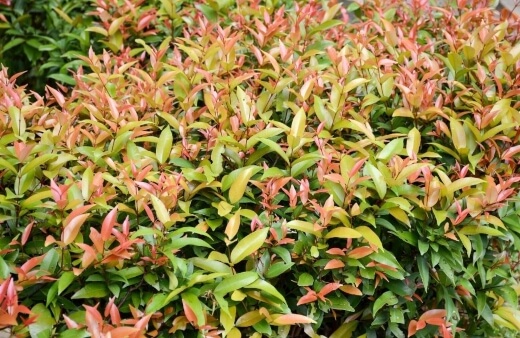
Commonly known as brush cherry, scrub cherry and watergum. This rainforest tree is native to eastern Australia and usually grows as a small to medium tree up to 20 metres tall in gardens.
Lilly Pilly (Syzygium smithii)

Source: en.wikipedia.org
Formerly known as Acmena smithii, this variety is a summer-flowering, winter-fruiting evergreen tree that is now commonly known as Monkey Apple or Lilly Pilly.
This is a smaller growing variety reaching an average height of about 3 to 5 metres tall and is therefore usually planted as shrubs or used as a lilly pilly hedge.
Magenta Lilly Pilly (Syzygium paniculatum)

Source: gardensonline.com.au
Known as magenta lilly pilly or magenta cherry, this variety is native to New South Wales and is a broad, dense and bushy rainforest tree. Cultivated varieties grow up to 15 metres tall.
See our in-depth guide to growing Syzygium paniculatum for more details.
Riberry (Syzygium luehmannii)

Source: gardeningwithangus.com.au
This variety is a medium-sized coastal rainforest tree commonly known as Riberry or small-leaved lilly pilly. It is widely grown as an ornamental garden tree and is popular for its fruits known as riberries.
Blue Lilly Pilly (Syzygium oleosum)

Source: gardensonline.com.au
Common names include blue lilly pilly and blue cherry, this species of Syzygium tree is native to the eastern Australian rainforests and is a smaller growing variety, growing from 4 to 12 metres tall.
Check out our guide to growing Syzygium oleosum for more details.
Rose Apple (Syzygium jambos)
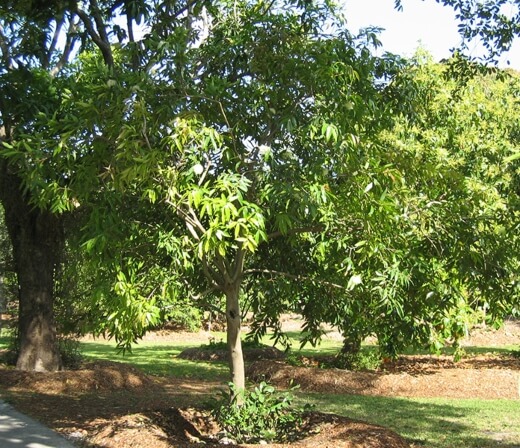
Source: ntbg.org
This variety can grow as a large shrub or a small to medium-sized tree reaching a height of around 12 to 15 metres. Commonly known as Rose Apple, this variety is native to Southeast Asia and is widely used as an ornamental fruiting garden tree.
Here is our in depth guide on growing Rose apple.
Powderpuff Lilly Pilly (Syzygium wilsonii)
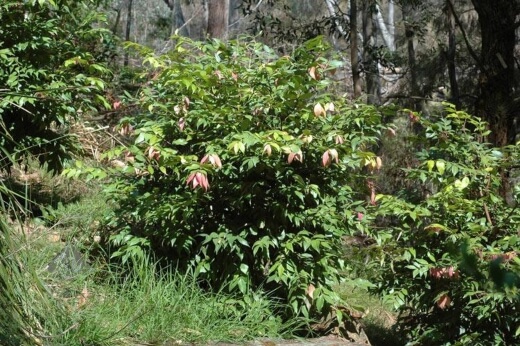
Source: tropical.theferns.info
Known as the Powderpuff Lilly Pilly, this small growing shrub variety is native to the northern Queensland rainforests.
It is a highly attractive and versatile variety that boasts stunning unique red flowers, foliage and clusters of fruits.
Coolamon (Syzygium moorei)

Source: trusttrees.org.au
This is a rare subtropical rainforest tree from New South Wales and south east Queensland. Commonly known as coolamon, watermelon tree and durobby, this variety of Lilly Pilly features a canopied growth habit and can reach up to 40 metres high.
Java Plum (Syzygium cumini)

Source: plantsdescription.blogspot.com
Commonly referred to as Malabar plum, Java plum or black plum, this fast-growing variety is native to regions of Southeast Asia and is now widely grown as a tropical, ornamental flowering tree reaching a height of up to 30 metres.
Giant Water Gum (Syzygium francisii)
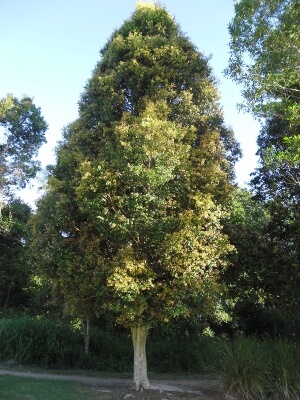
Source: ppnn.org.au
Native to Australia, this variety is commonly known as giant water gum or Francis water gum and grows to be over 30 metres tall.
River Cherry (Syzygium tierneyanum)

Source: emahotrees.com.au
This evergreen tree grows dense and spreading and can reach up to 10 to 12 metres in height. Commonly known as river cherry or water cherry, this variety makes for a great lilly pilly hedge thanks to its spreading habit.
Ringwood (Syzygium anisatum)
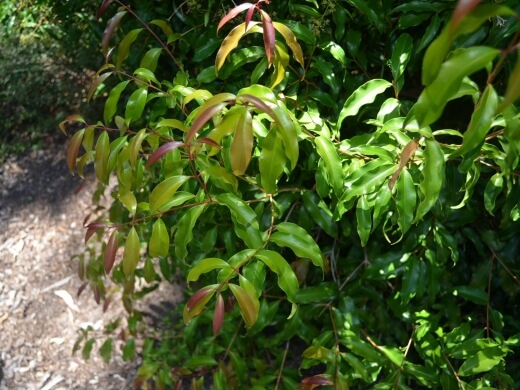
Source: gardeningwithangus.com.au
Known as Ringwood or aniseed tree, this variety is another rare Australian rainforest tree with aromatic leaves that contain an essential oil profile.
These trees are mostly cultivated for their use as a flavouring spice or herbal tea ingredient.
Water Rose Apple (Syzygium aqueum)
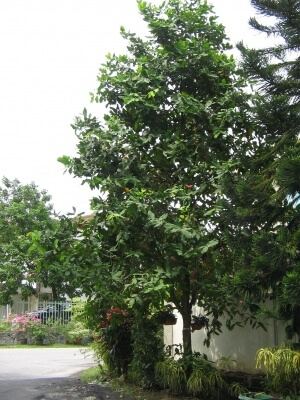
Source: tropical.theferns.info
Commonly known as watery rose apple or bell fruit, this variety is a species of brush cherry tree that is widely cultivated for its wood and edible fruits.
Cloves (Syzygium aromaticum)
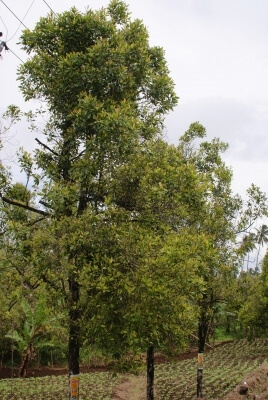
Source: tropical.theferns.info
Cloves are the aromatic flower buds of this tree variety. Native to Indonesia, these trees are cultivated for their cloves which are used in spices around the world.
Weeping Lilly Pilly (Syzygium floribundum)

Source: sassafras.id.au
Native to the rainforests of eastern Australia, this variety is commonly known as the weeping lilly pilly. Widely used as an ornamental garden plant, this variety is a medium to large tree growing up to 30 metres tall.
Syzygium ‘Cascade’ (Syzygium luehmannii x Syzygium wilsonii)
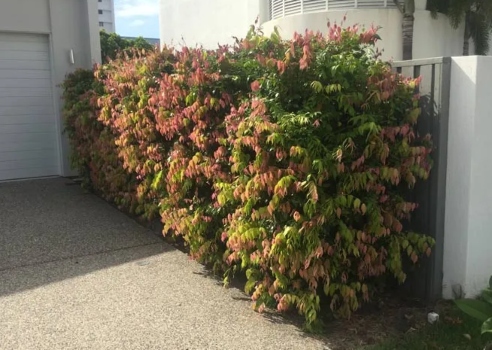
Source: Hedging and Screening
Sometimes referred to as weeping lilly pilly, this fantastic hybrid cultivar is loved for its tasty berries, evergreen weeping foliage, spectacular pink powder-puff flowers and brilliantly bright-pink new growth.
It is considered one of the most ornamental shrub varieties of lilly pilly, growing to around 2 to 4 metres tall and 1 to 3 metres wide.
Here is our guide on growing Lilly Pilly Cascade.
Lilly Pilly ‘Resilience’

Source: oxleynursery.com.au
This prized lilly pilly cultivar is perfect for those looking for a fast-growing option for screening or hedging applications. It features large and very glossy foliage compared to its counterparts, growing to around 4 to 5 metres tall and 2 to 3 metres wide in cultivation.
Like many others in its genus, this cultivar also produces bronze new growth, fluffy white flowers and attractive, edible pink fruits.
This specific cultivar has also been bred to be highly resistant to many common lilly pilly pests and diseases, making it a very low-maintenance choice for gardens.
Brush Cherry |  |
Lilly Pilly (Syzygium smithii)Formerly known as Acmena smithii, this variety is a summer-flowering, winter-fruiting evergreen tree that is now commonly known as Monkey Apple or Lilly Pilly. This is a smaller growing variety reaching an average height of about 3 to 5 metres tall and is therefore usually planted as shrubs or used as a lilly pilly hedge. Check out our complete growing guide on Syzygium smithii. |  Source: en.wikipedia.org |
Magenta Lilly Pilly |  Source: gardensonline.com.au |
Riberry (Syzygium luehmannii)Syzygium luehmannii is a medium-sized coastal rainforest tree commonly known as Riberry or small-leaved lilly pilly. It is widely grown as an ornamental garden tree and is popular for its fruits known as riberries. |  Source: gardeningwithangus.com.au |
Blue Lilly Pilly |  Source: gardensonline.com.au |
Rose Apple (Syzygium jambos)This variety can grow as a large shrub or a small to medium-sized tree reaching a height of around 12 to 15 metres. Commonly known as Rose Apple, this variety is native to Southeast Asia and is widely used as an ornamental fruiting garden tree. Here is our in depth guide on growing Rose apple. |  Source: ntbg.org |
Powderpuff Lilly Pilly (Syzygium wilsonii)Known as the Powderpuff Lilly Pilly, this small growing shrub variety is native to the northern Queensland rainforests. It is a highly attractive and versatile variety that boasts stunning unique red flowers, foliage and clusters of fruits. |  Source: tropical.theferns.info |
Coolamon (Syzygium moorei)This is a rare subtropical rainforest tree from New South Wales and south east Queensland. Commonly known as coolamon, watermelon tree and durobby, this variety of Lilly Pilly features a canopied growth habit and can reach up to 40 metres high. |  Source: trusttrees.org.au |
Java Plum (Syzygium cumini)Commonly referred to as Malabar plum, Java plum or black plum, this fast-growing variety is native to regions of Southeast Asia and is now widely grown as a tropical, ornamental flowering tree reaching a height of up to 30 metres. |  Source: plantsdescription.blogspot.com |
Giant Water Gum |  Source: ppnn.org.au |
River Cherry |  Source: emahotrees.com.au |
Ringwood (Syzygium anisatum)Known as Ringwood or aniseed tree, this variety is another rare Australian rainforest tree with aromatic leaves that contain an essential oil profile. These trees are mostly cultivated for their use as a flavouring spice or herbal tea ingredient. |  Source: gardeningwithangus.com.au |
Water Rose Apple |  Source: tropical.theferns.info |
Cloves (Syzygium aromaticum)Cloves are the aromatic flower buds of this tree variety. Native to Indonesia, these trees are cultivated for their cloves which are used in spices around the world. |  Source: tropical.theferns.info |
Weeping Lilly Pilly |  Source: sassafras.id.au |
Syzygium ‘Cascade’ (Syzygium luehmannii x Syzygium wilsonii)Sometimes referred to as weeping lilly pilly, this fantastic hybrid cultivar is loved for its tasty berries, evergreen weeping foliage, spectacular pink powder-puff flowers and brilliantly bright-pink new growth. It is considered one of the most ornamental shrub varieties of lilly pilly, growing to around 2 to 4 metres tall and 1 to 3 metres wide. |  Source: Hedging and Screening |
Lilly Pilly ‘Resilience’This prized lilly pilly cultivar is perfect for those looking for a fast-growing option for screening or hedging applications. It features large and very glossy foliage compared to its counterparts, growing to around 4 to 5 metres tall and 2 to 3 metres wide in cultivation. Like many others in its genus, this cultivar also produces bronze new growth, fluffy white flowers and attractive, edible pink fruits. This specific cultivar has also been bred to be highly resistant to many common lilly pilly pests and diseases, making it a very low-maintenance choice for gardens. |  Source: oxleynursery.com.au |
How to Grow Lilly Pilly
Lilly Pilly have quite flexible growing requirements and specific needs will depend on the cultivar you have chosen to grow. It is important to note that not all varieties of Lilly Pilly are fruit bearing.
Most varieties grow quite happily in the garden but also make fabulous container plants. You will need to note that Lilly Pillies sometimes have invasive root systems, so be sure to give them plenty of space to grow if you are planting a large variety.
In general, Lilly Pillies enjoy full sun or partial shade, moist soil and slightly salty conditions. Choose a good quality soil, which offers adequate drainage. Clay or loam soil is also suitable.
How to Grow Lilly Pilly from Seeds
This cultivar is incredibly easily grown from seeds; however, they are rather slow to germinate. So, patience is key.
You can collect seeds directly from fresh fruits once they have ripened. Here’s what you should do:
- Remove the fruit from around the seed and clean the seed of any debris.
- Place the seed into a seeding tray with high-quality seeding mix.
- Keep your seeding tray in a warm and humid climate.
- Be sure to keep the soil moist to enable germination.
How to Grow Lilly Pilly from Cuttings
While this is a slightly harder method, it is possible to propagate Lilly Pilly from a cutting. Here’s how:
- Use a sterilized grafting knife to remove a cutting about 10 cm in length.
- Remove all of the leaves on the lower half of the cut and cut back the leave on the top half.
- Dip the dried, cut-end into a rooting hormone. Then plant into a potting mix.
- Be sure to give each cutting its own pot.
Tips on Planting Lilly Pilly
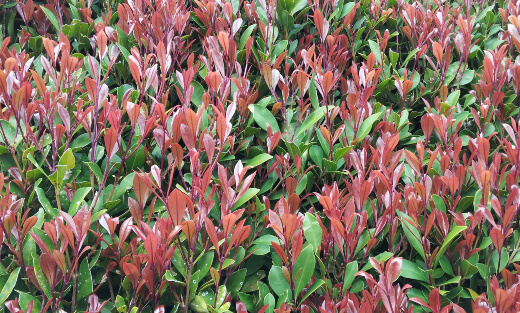
Source: Brenlissaonlinenursery.com.au
Planting is an important process, so you’ll want to make sure you’re doing right and giving your plant plenty of room to grow.
Firstly, prepare your soil with a slow-release fertiliser before planting. Then:
- Dig a hole twice the size of your root ball.
- Gently tease the roots of your Lilly Pilly plant and place into the hole and backfill.
- Form a raised ring or donut around the base to help it retain water.
- Mulch the area around the doughnut. A mix of sugar cane is recommended as it tends to hold more moisture.
When it comes to spacing out your plants, it’s always good to go with a 3:1 rule. If you’re hoping to grow your plant to 2 meters tall, space then 60cm apart.
Of course, if you’re planting into individual pots, just make sure the pot is at least twice the size of the root ball.
How to Care for Lilly Pilly Plants
Once established, Lilly Pillies are quite hardy and easy going. However, they’ll take a solid 3 to 5 years to reach full maturity. Lilly Pillies don’t do well in extreme cold so be sure to protect from extreme, frosting temperatures and clear of drying, freezing winds.
The main things you'll need to consider with Lilly Pillies is regular watering, pruning and fertilising.
Pruning

Pruning is a great way to keep your Lilly Pilly the size you want it and it can take quite aggressive pruning without a problem. Be sure to prune at least once a year and water the soil well before and after pruning.
It is recommended to do so only after its flowering season.
Fertilising
Lilly Pillies do well with some fertilisation at least every spring. You can either use compost or fertiliser.
Watering
These plants enjoy moisture, so be sure to water them often. The soil should remain slightly moist at all times. However, waterlogging will pose a problem. Well-draining soil should help with this.
Best Lilly Pilly Hedge and Screening Varieties
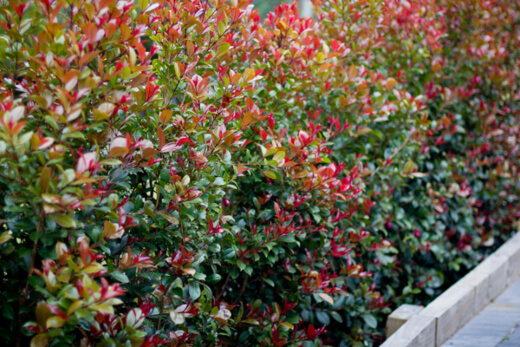
Source: Thetutuguru.com.au
There are many varieties of Lilly Pilly that make for excellent hedging options. Being able to function in both formal and more relaxed and wilder gardens, a lilly pilly hedge offers tough native characteristics and ideal growth habits for hedging and screening purposes.
Oftentimes the colourful flowers and edible fruits will attract local wildlife while being able to add gorgeous splashes of native colour to your natural spaces. These plants can generally grow in narrow spaces and they respond well to pruning.
There is a large array of cultivars catering to any style of lilly pilly hedge. Here are our top 5 varieties for hedging and screening:
- Acmena smithii ‘Allyn Magic’ - This is a very adaptable plant and it features an ideal compact growth habit for hedges and screens.
- Acmena smithii ‘Cherry Surprise’ - This is a taller growing ‘smithii’ variety that is perfect for anyone who needs more height in their landscape.
- Syzygium francisii 'Giant Water Gum' - This variety is great for lower hedges and screens.
- Syzygium australe ‘Scrub Cherry’ - This is one of the most widely used varieties for hedging and screening. This plant can tolerate being grown in narrower spaces and features highly attractive foliage, fruits and flowers so it makes for an excellent ornamental addition to any garden.
- Syzygium paniculatum ‘Magenta Cherry’ - The soft and lush foliage this plant features is perfect for hedging and screening. This variety produces white puffy blooms and nutritious edible fruits.
For more on hedging options, check out our full gardening guide on the best Australian Native Hedge Plants.
Common Lilly Pilly Pests & Diseases
Especially when kept outdoors, you may find some sap-sucking insects on your plant. The three most prominent issues with Lilly Pillies include:
Lilly Pilly Psyllid
Also known as Trioza Eugeniae, psyllids are insects which burrow into the leaves of the Lilly Pilly. While it’s not fatal for your plant, they do cause unsightly, pimple-like deformations on the leaves of your plants.
Luckily, these are treatable with a good insecticide.
Scale
Lilly Pilly is native to Australia and there are quite a few Aussie plants which suffer from scale. This will only become an issue when the plant reaches maturity, however, it can pose devastating if not treated.
Ladybugs are known to prevent scale or treat it with white oil.
Myrtle Rust
Some Lilly Pilly varieties have been bred to be resistant to rust, but it’s not always easy to tell if yours is. Be sure to remove any affected foliage and treat immediately with a fungicide.
Lilly Pilly Fruits - Bush Tucker Guide
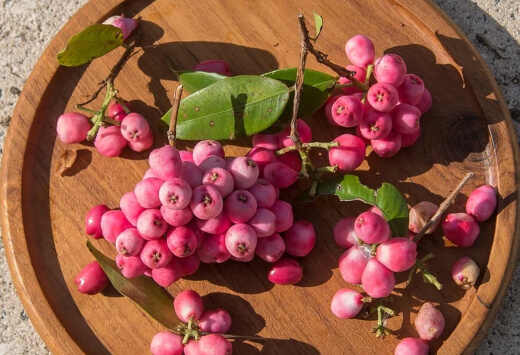
Fruit-bearing Lilly Pilly plants offer up some fantastically delicious berries, known as a riberry, which are good for you and great to eat. Aboriginal Australians used the berries of the Lilly Pilly to prevent colds and even fight infections.
In terms of nutrition, Lilly Pilly berries are known to:
- Be high in Vitamin C.
- Be a great anti-oxidant and boost the immune system.
- Reduce inflammation
- Boost collagen production in the skin.
The berries are quite tart when eaten raw, so it’s often cooked, baked or boiled. Due to its diverse, spice-filled flavor it actually has a lot of culinary applications.
It’s often used in salads or in salad dressing, in smoothies or over ice cream, mixed into muffins, cakes and pies and anywhere where it can enhance flavour.
You can even turn it into a refreshing cordial. Check out this simple Lilly Pilly Cordial Recipe for an easy way to enjoy your garden’s harvest.
More so, Lilly Pillies are great when paired with meats like Kangaroo, Poultry and Pork. For those cheese-lovers, it’s also fantastic with Cheddar, Manchego and aged Gouda.
Bush Tucker Tips
You will know the fruits are ready to eat and be harvested when they turn blue or purple. Fruits are normally harvested from early December through to mid-January and you can simply pluck ready fruits from the branches of your tree, wash and then store or use them.
Whether used in jams or enjoyed as a refreshing summer treat straight off the tree, riberries will need to be refrigerated or frozen as soon as possible after picking. They will keep in the fridge for up to 3 weeks and up to 2 years frozen.
Best Tasting Lilly Pilly Varieties
The fruits of the Creek Lilly Pilly, Syzygium australe, are particularly tasty. The slightly tarter fruits of the Syzygium luehmannii are also widely loved for their flavours.
The Blue Lilly Pilly berries make for excellent fruit-based additions to jams, jellies, sauces, syrups and wines.
Lilly Pilly Frequently Asked Questions
Are Lilly Pilly berries good for you?
These berries provide numerous skincare benefits and are a good source of vitamin C and other natural fruit acids. The berries are also known to have anti-aging and anti-inflammatory qualities.
Does Lilly Pilly have invasive roots?
There are over 60 varieties of Australian Lilly Pilly plants that range from small shrubs to large trees. Most of their root systems are generally non-invasive.
What do you do with Lilly Pilly fruit?
Traditionally, these berries were collected and eaten as dried fruit throughout the year. Today, they are commonly made into chutneys, jams, jellies, sauces and anything else that needs spicy-sweet berries in it.
How far apart do you plant Lilly Pilly hedge?
It is recommended to plant lilly pillies 50cm to 1m apart if being used as a hedge or screen. Planting distances will vary depending on which variety you grow but generally try to keep at least 75cm of spacing between the plants.
Wrapping Up Our Lilly Pilly Growing Guide
There really are so many applications for this fabulous fruit. So, why not start growing some of your very own Lilly Pilly plants in your garden. Plus, it’s even safe for pets.
Whichever variety of this Australian native you choose, just be sure to keep that soil moist and jam-packed with nutrients. If you’re choosing a variety for hedging or screening, be sure to give your plants plenty of space to grow and keep up with regular pruning.
Easily propagated, and fairly easy to grow, now you have everything you need to know to start growing lilly pilly today!

Published on January 29, 2023 by Nathan Schwartz
Last Updated on January 26, 2025




